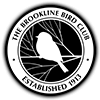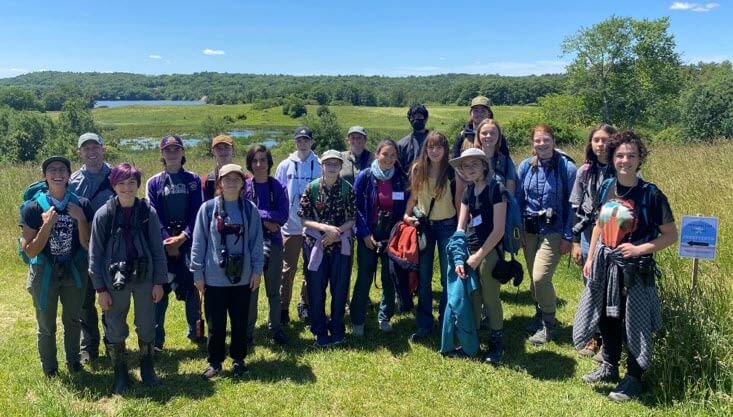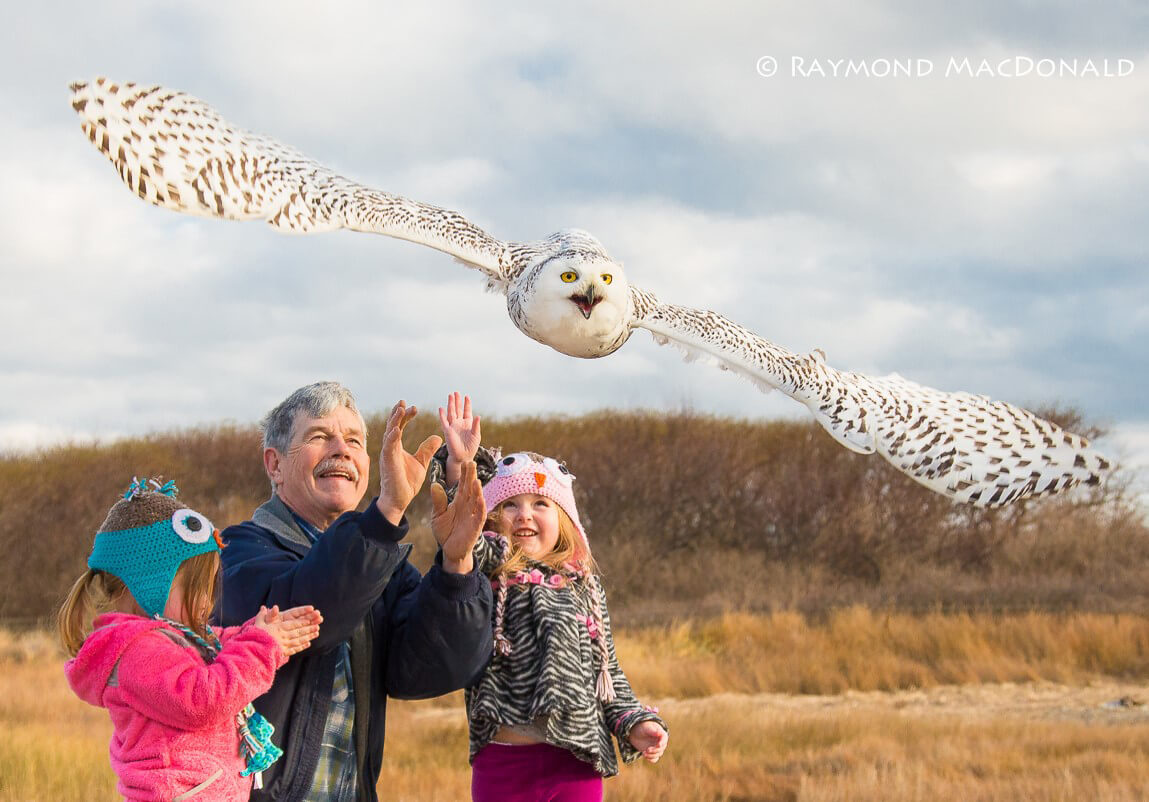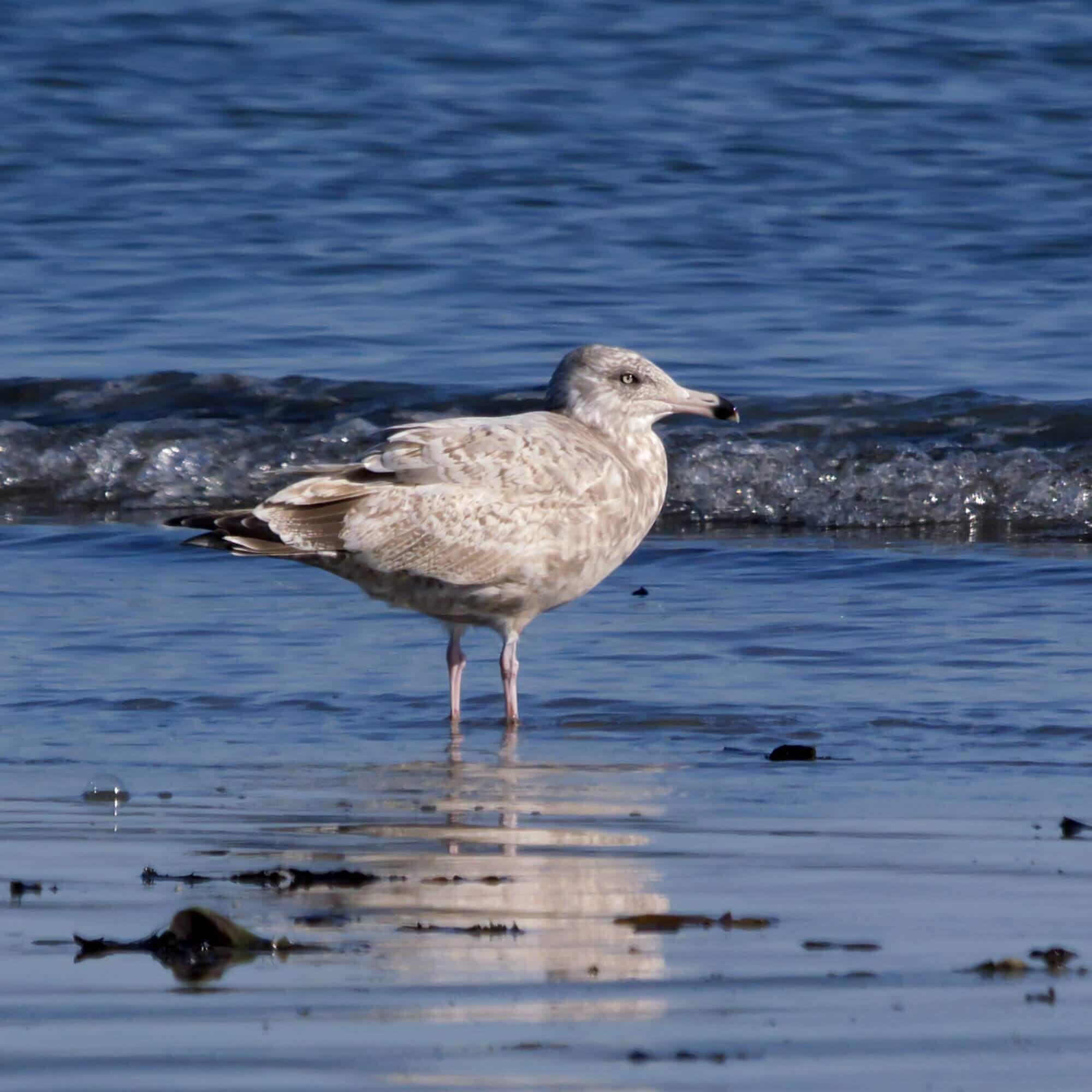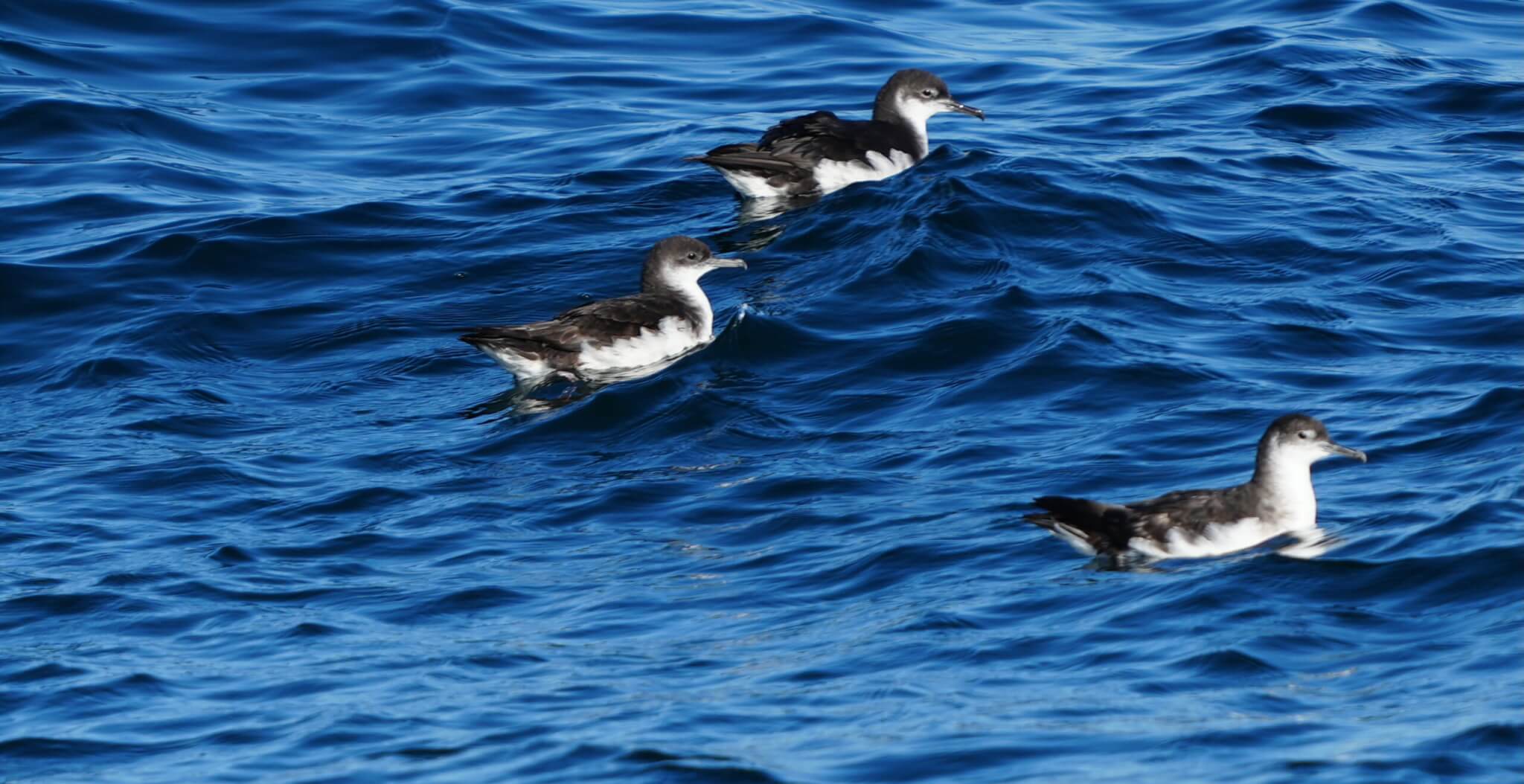Thanks to Nick Bonomo for this trip report.
On the heels of a weather cancellation of our August overnight pelagic trip, we were a bit nervous that the September trip might suffer the same fate. Lucky for us, Hurricane Humberto accelerated into the open North Atlantic, so the Brookline Bird Club would reach the edge of the continental shelf in 2019 after all.
Forty-seven hopeful birders boarded the Helen H in Hyannis early on Saturday, September 21st, in the hands of legendary Captain Joe Huckemeyer and his trusty crew. Capt. Joe informed us that we would face minor residual swell from the hurricane at first, but that seas would progressively calm through the weekend.
We had only successfully run a few of these late September trips before, so these waters remain exceedingly underexplored at this point in the season. We know that the shelf edge southeast of Nantucket produces great birds throughout the summer, so there’s no reason to think the first days of autumn should be any different. Hopes were boosted by the sea surface temperature maps, which showed a core of warm water edging right up to our proposed route. The combination of accessible warm water and sharp temperature breaks is often a recipe for success on these trips. Would we be in for a surprise or two? (Spoiler Alert: Yes.)
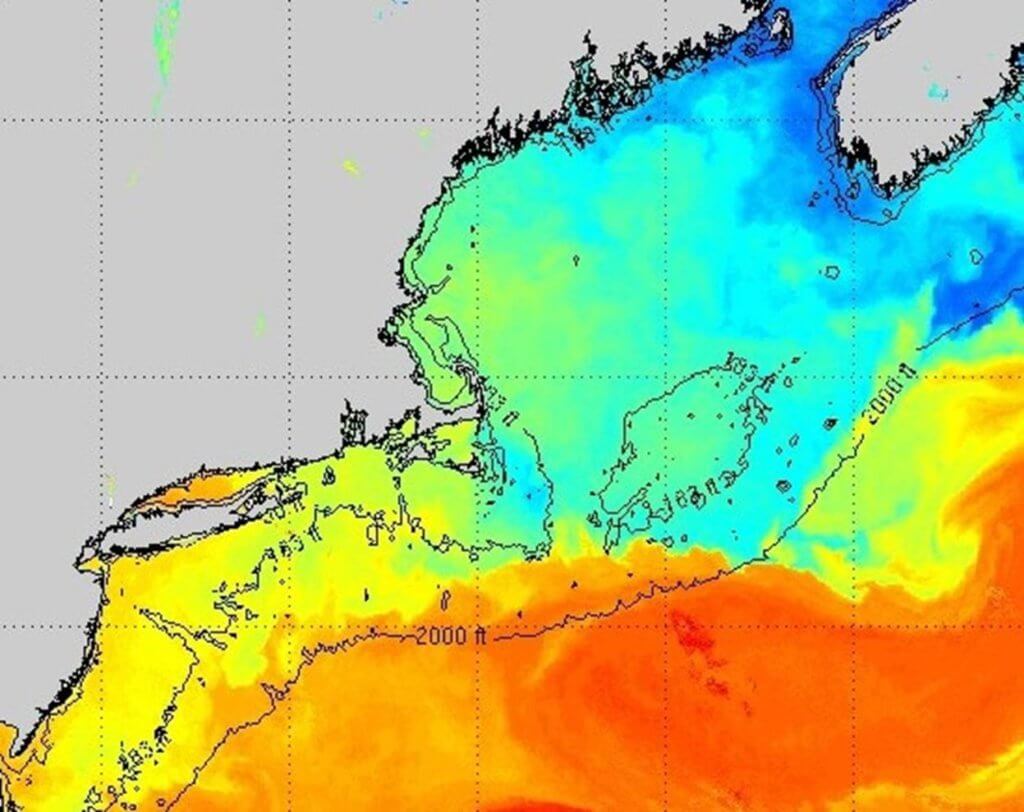
Sea surface temps off the northeast coast.
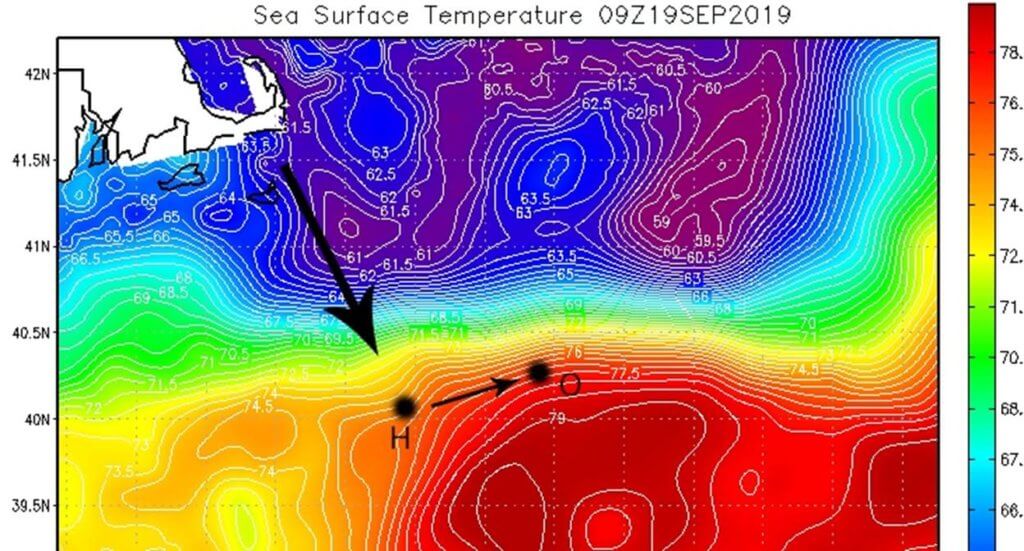
Sea surface temps with our proposed route. H=Hydrographer Canyon, O=Oceanographer Canyon
Barely out of Nantucket Sound, a juvenile SABINE’S GULL was spotted off the port side. We were able to stay with this bird for a bit, enjoying in-flight and on-water views of this striking larid. We were off to a hot start! Around the same time we passed our first tubenose, a light morph NORTHERN FULMAR that was sitting on the water. At this early date, this cold-water species is rather uncommon in these parts. Little did we know, this would only be the first of a spectacular showing of this species throughout the weekend.
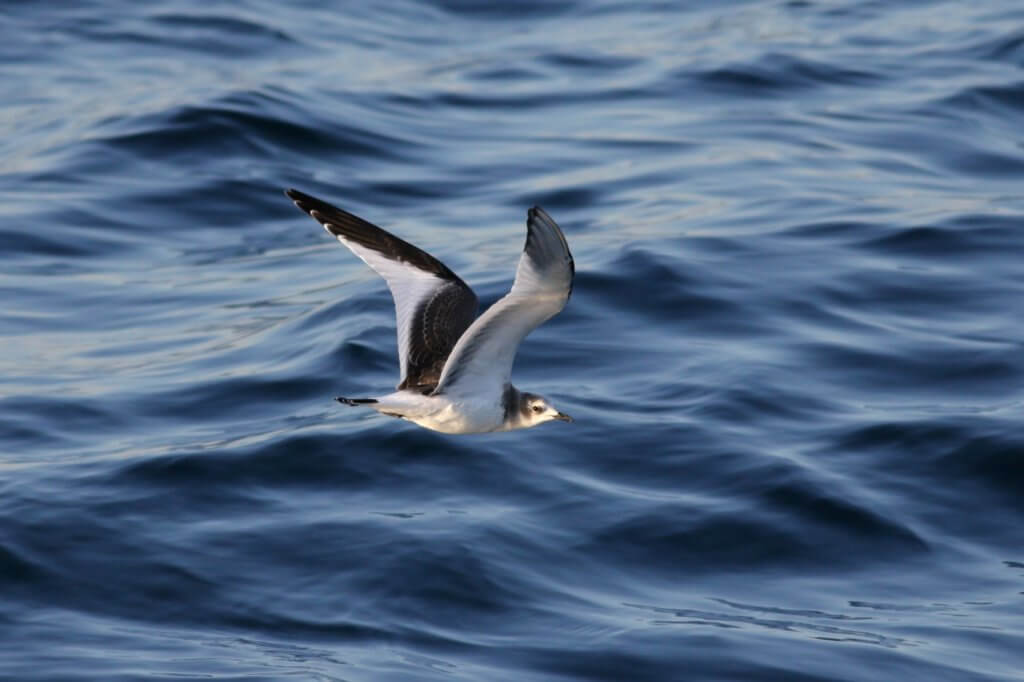
Sabine’s Gull. Photo credit Nick Bonomo.
As we continued east of Nantucket, we passed by a steady trickle of gulls and terns. Among the Laughing, Herring and Great Black-backed Gulls were several LESSER BLACK-BACKED GULLS, a species that continues to take over the world. Distant views of BLACK TERNS were had among Common Terns. Our first NORTHERN GANNETS were seen. A flock of three WOOD DUCKS, appearing very much out of place, was heading north towards Cape Cod.
Someone spotted a large whale off the port side of the boat, and we were treated to brief but satisfying views of a HUMPBACK WHALE as it dove out of sight.
The Nantucket Shoals lie southeast of their eponymous island; this expansive patch of undulating sandy bottom is a nutrient-rich area known for constant upwelling of cold bottom water. We could feel the chill in the air as we passed through 60-degree surface temps. Along with this upwelling often comes a concentration of bait and birds. The Shoals were quieter today than we’re used to seeing, though one must be reminded that we did a single transect through a very large piece of water. Still, we had a smattering of GREAT and CORY’S SHEARWATERS, and yet more NORTHERN FULMARS.
While birding at sea, any experience with a land bird tends to be some combination of exciting and somber. There is the undeniable thrill of watching migration in action and being impressed by these individuals that continue to fight for survival while they attempt to reorient themselves. On the other hand, several of these birds may perish from exhaustion before they find land. Our first lost soul of the weekend belonged to a NORTHERN FLICKER. We weren’t terribly far from Nantucket at that point, so there was certainly hope for that one.
As we neared the south end of the Nantucket Shoals, our second woodpecker species appeared in the form of a YELLOW-BELLIED SAPSUCKER. You never know what’s going to appear overhead.
After we pass the productive Nantucket Shoals, we often find ourselves in a relatively birdless stretch until we reach the vicinity of the canyons, which is a distance of about 50 miles. This time, though, several miles before the shelf edge we found ourselves in a swarm of feeding NORTHERN FULMARS, GREAT SHEARWATERS, and WILSON’S STORM-PETRELS. The water here had spiked to 74 degrees. As our fishermen crew would find out, these birds were feeding over Yellowfin Tuna. The count of Fulmars in this flock reached a staggering 70+ individuals, one of which was a dark morph bird.
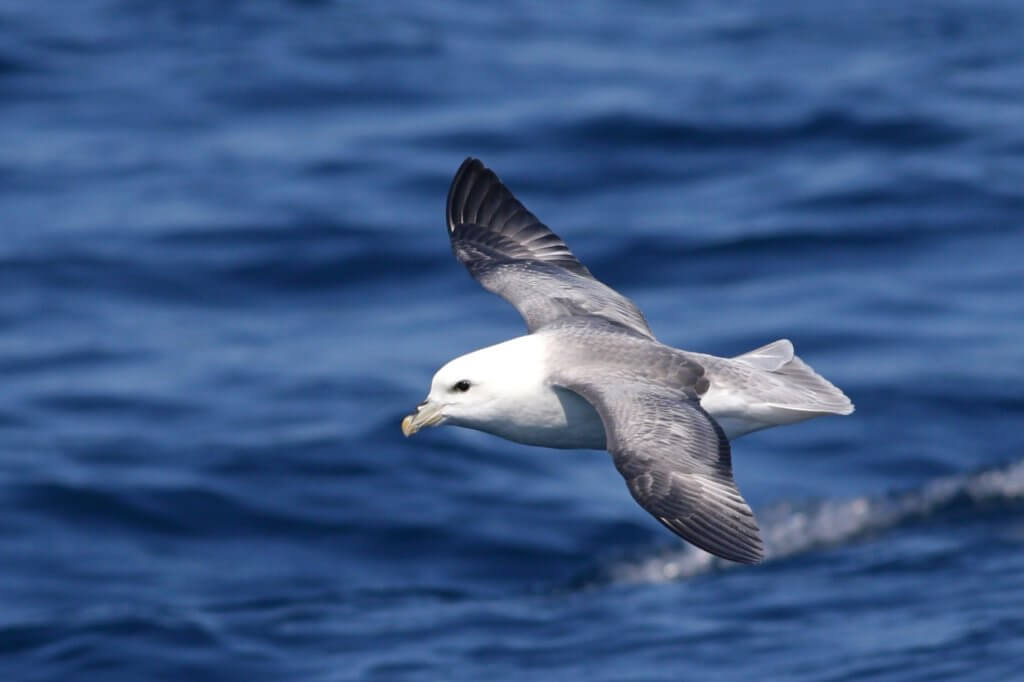
Northern Fulmar. Photo credit Nick Bonomo.
Eventually we had to tear ourselves away from these birds and continue our journey to the edge of the continental shelf, which we were nearing. OFFSHORE BOTTLENOSE DOLPHINS made an appearance near the boat. We arrived at the northern tip of Hydrographer Canyon at 1pm and proceeded to its mouth, where we turned eastward to follow the edge of the shelf. This stretch of “the edge,” which over the next 50 miles includes Dogbody, Welker, and Oceanographer Canyons, has treated us very well in the past. It didn’t take long for our first deep water specialty to pop up in the form of a BLACK-CAPPED PETREL, our first of five (!) sightings for the trip.
The Black-capped Petrel is a species that breeds in the Caribbean and spends much of its time feeding in the Gulf Stream; they are a common sight on pelagic trips out of Hatteras, NC. The more time we spend offshore southern New England, the more we seem to be encountering this species in the warmer, deeper waters off “the edge.” Close scrutiny off North Carolina has shown that there may be two forms of Black-capped Petrel, often described as “white-faced” and “dark-faced.” The two types differ slightly in plumage and molt timing, though there are intermediate-appearing birds. Interestingly, it seems that the overwhelming majority of Black-capped Petrels seen this far north fit into the “white-faced” category, which may indicate a very real difference in range. In fact, there are no eBird records of “dark-faced” birds north of North Carolina. In keeping with the track record, our first Black-cap of the trip was one of the “white-faced” birds.
Our first jaeger of the trip, an adult light morph POMARINE complete with “spoons,” was well-seen. The parade of new species continued when a subadult BROWN BOOBY sneaked in below the horizon and popped up rather close to the boat! This is a new species for these BBC pelagic trips, though Capt. Joe has seen a few while out fishing in recent years. The story of the northward explosion of Brown Boobies continues to write itself and is showing no signs of slowing down.
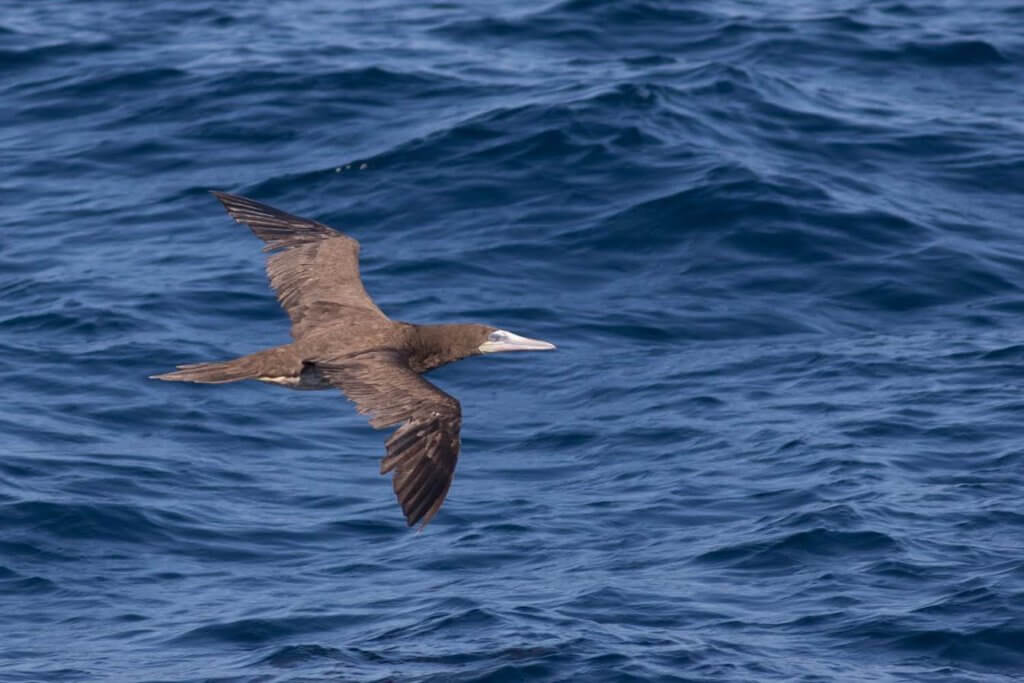
Brown Booby. Photo credit Tom Johnson.
A bit lost in all the excitement were the first couple LEACH’S STORM-PETRELS of the trip. While we are sometimes treated to boat-side views of this species, more often than not they tend to steer clear of vessels. This would be the theme for this weekend, though we did have prolonged views of a handful of Leach’s off the bow while we were underway.
The same Brown Booby made a few more appearances through the afternoon as we continued eastward, occasionally chasing flying fish! It certainly felt as if it was sizing us up for a landing, but that never quite happened.
Our second BLACK-CAPPED PETREL, this one intermediate in plumage type, made a much closer pass than the first one did, thrilling the group. Any encounter with a gadfly petrel is a special one – just can’t get enough of ‘em!
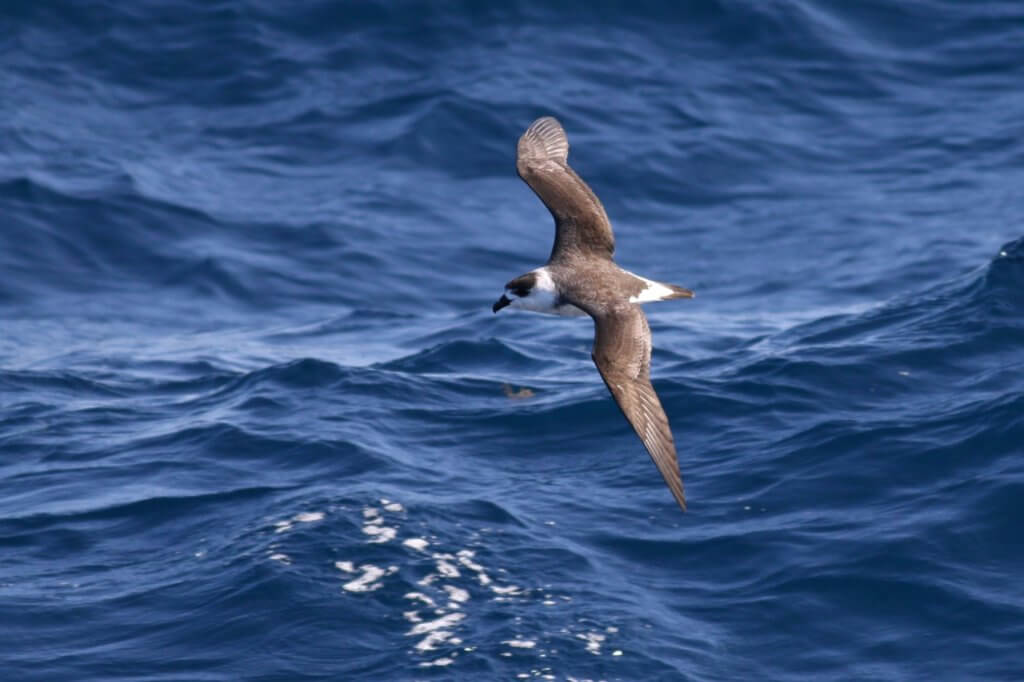
Black-capped Petrel. Photo credit Nick Bonomo.
As we passed Welker Canyon, heading in the direction of Oceanographer, bird volume started to pick up a bit. We saw yet another BLACK-CAPPED PETREL (white-faced). This bird would lead us to an active feeding flock of tubenoses that was working over schools of skipjack tuna. Our trickle of birds had turned into a beehive.
A few minutes before 5pm the mood on the boat abruptly turned from leisurely to tense when a dainty gadfly petrel was spotted entering the fray. “GET ON THIS PETREL – THE SMALLER ONE!!”
That smaller petrel revealed itself to be a BERMUDA PETREL. The Cahow. The Lazarus species. The east coast pelagic Grail Bird.
There was lots of yelling and cursing and pointing and shutter-clicking all at once. Those first few moments were filled with heavy doses of pure joy and anxiety. I can tell you from a leader’s perspective that it was more of the latter. This is a bird that everybody needed to see. And Pterodromas are quite well known for their fleeting passes! Luckily for everyone on board, we would have no such trouble. This bird performed better than anyone could have hoped. It’s hard to believe, but we stayed with this Cahow for 40 enthralling minutes! Long enough for co-leader Tom Johnson to tell the entire history of the species’ disappearance, rediscovery, and ongoing recovery efforts…all while we were watching this bird do its thing right in front of us. Unreal.
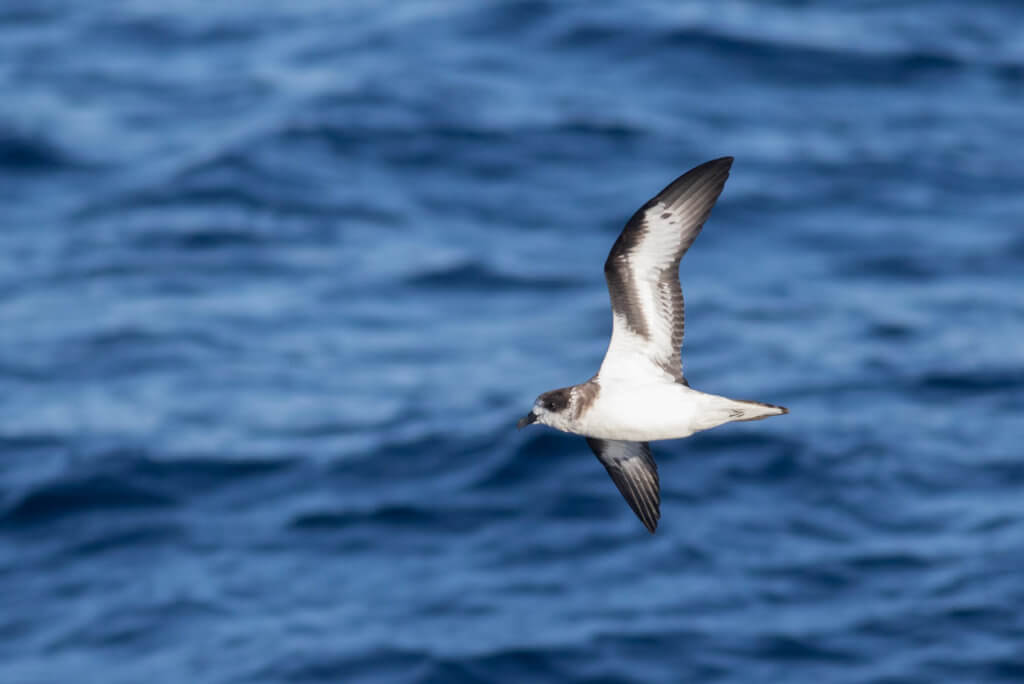
Bermuda Petrel. Photo credit Tom Johnson.
While the focus was entirely on the Bermuda Petrel for the duration of its stay, one couldn’t help but notice the incredible seabird composition of this flock. At one point also present with the Cahow were Black-capped Petrel, Brown Booby, and Northern Fulmar, in addition to more common species. Three of those are Massachusetts review species!
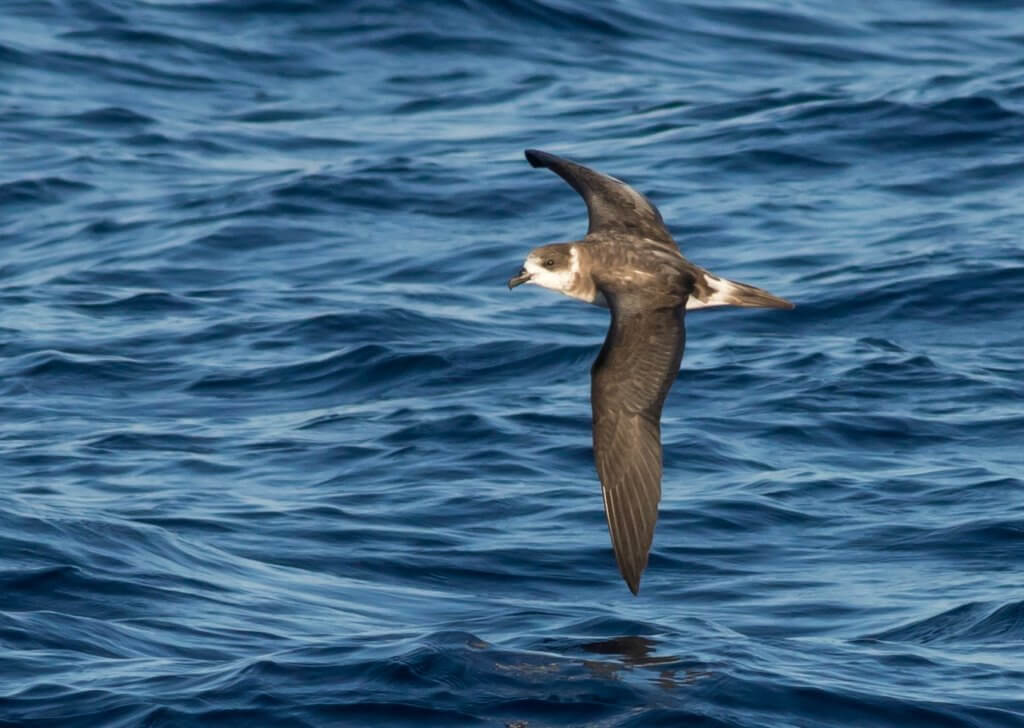
Bermuda Petrel. Photo credit Nick Bonomo.
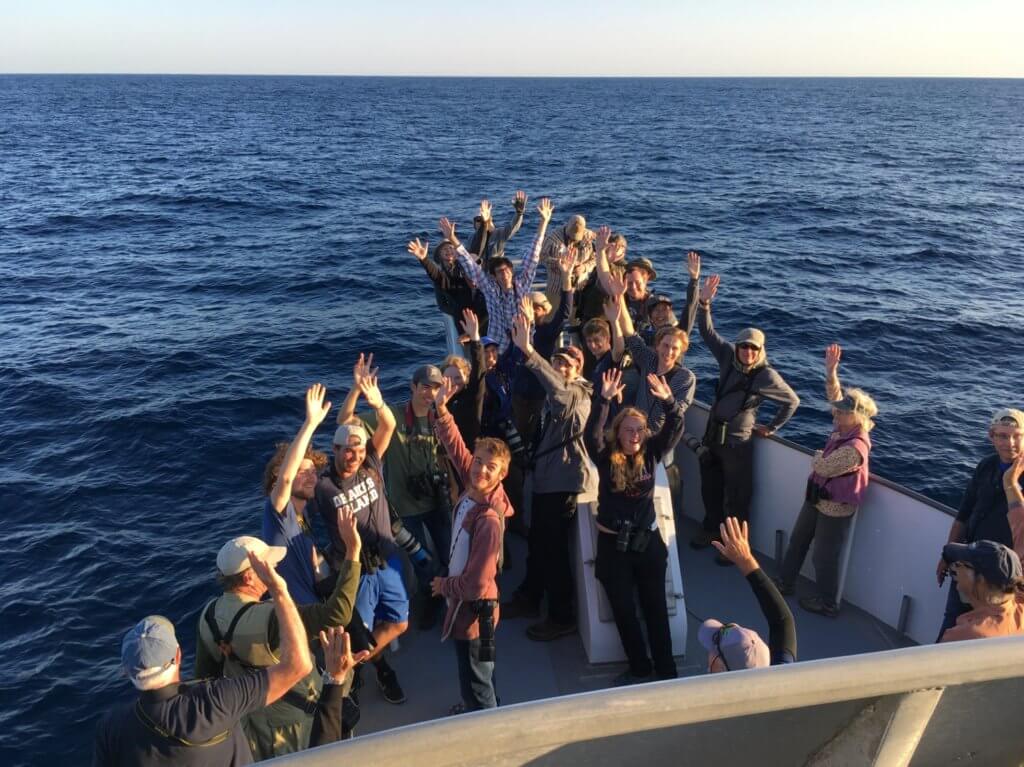
A very happy bow full of birders. Hey, who just saw an awesome life bird?
The entire boat was on such a high for the rest of the evening that we might as well have been floating over the water. It nearly felt like that, too, as the seas had subsided further. One more BLACK-CAPPED PETREL (intermediate facial pattern) concluded our birding for the day. Perfectly clear skies allowed for the elusive “Green Flash” to be seen on the horizon at sunset – yet another lifer for many on board.
On Sunday we awoke to glassy seas and Wilson’s Storm-Petrels fluttering through our chum slick. As we were pulling away from the slick, our fifth BLACK-CAPPED PETREL (intermediate) made a brief appearance. A juvenile RING-BILLED GULL, unusual this far offshore, also hung out for a bit.
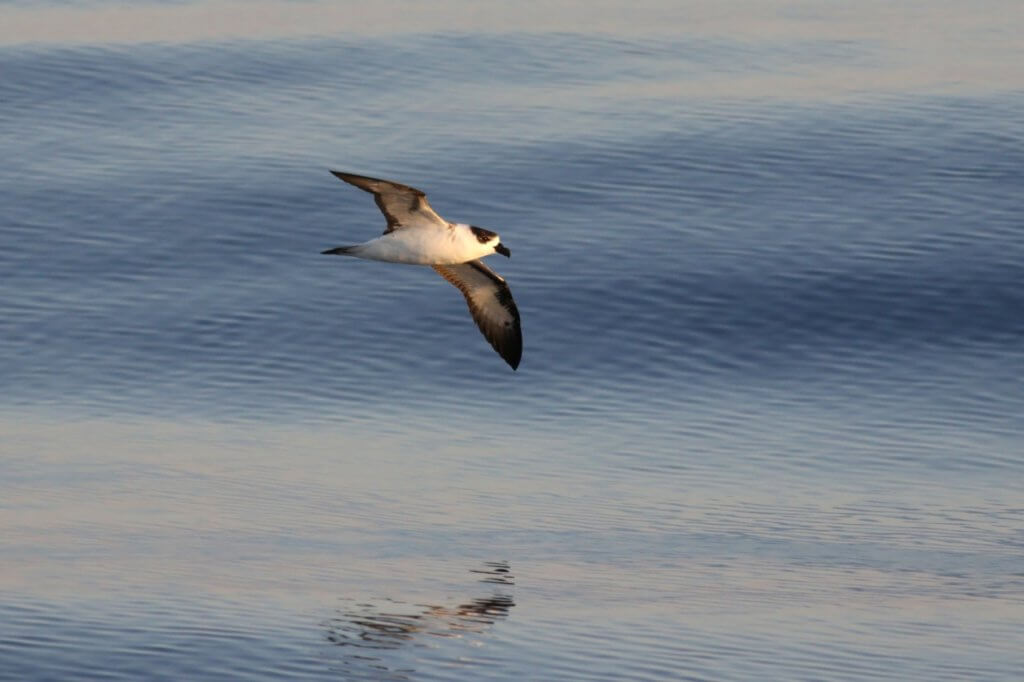
Black-capped Petrel. Photo credit Nick Bonomo.
We proceeded to work southwest into deeper, warmer water that surpassed 77 degrees at the surface. With hardly any wind to propel them, we were finding most birds sitting on the water. Perhaps our biggest target of the day was White-faced Storm-Petrel, a species that can be found in these waters somewhat reliably from July to September. We were nearing the end of their known window of occurrence, as their numbers likely peak in August and drop off sharply sometime during September. Still, we were hopeful. Diligent checks of every flock of sitting storm-petrels yielded only more Wilson’s and the occasional flighty Leach’s.
Calm seas made mammal viewing easy, and they stole the show this morning. Several pods of PILOT WHALES estimated at 70+ total individuals seemed to traveling in the same direction as us, followed by smaller numbers of the unmistakable RISSO’S DOLPHINS, showing off their scarred gray bodies, beakless melon-shaped heads, and tall dorsal fins. The beautiful morning light at our backs really seemed to accentuate the contrast between their white scars and gray ground color. We have had great luck finding this distinctive species over the years, specifically in these warm offshore waters.
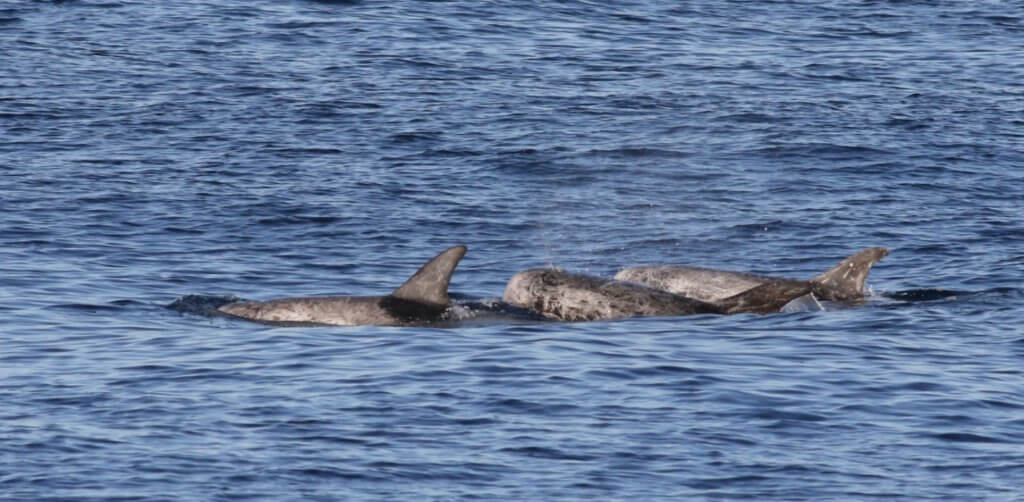
Risso’s Dolphins. Photo credit Nick Bonomo.
With the notable exception of one group of twelve AUDUBON’S SHEARWATERS, bird numbers seemed slimmer the further we pushed from the shelf edge. We decided to angle back northwest towards Welker Canyon. The dolphin show continued with yet more RISSO’S and OFFSHORE BOTTLENOSE for our viewing and photographing pleasure.
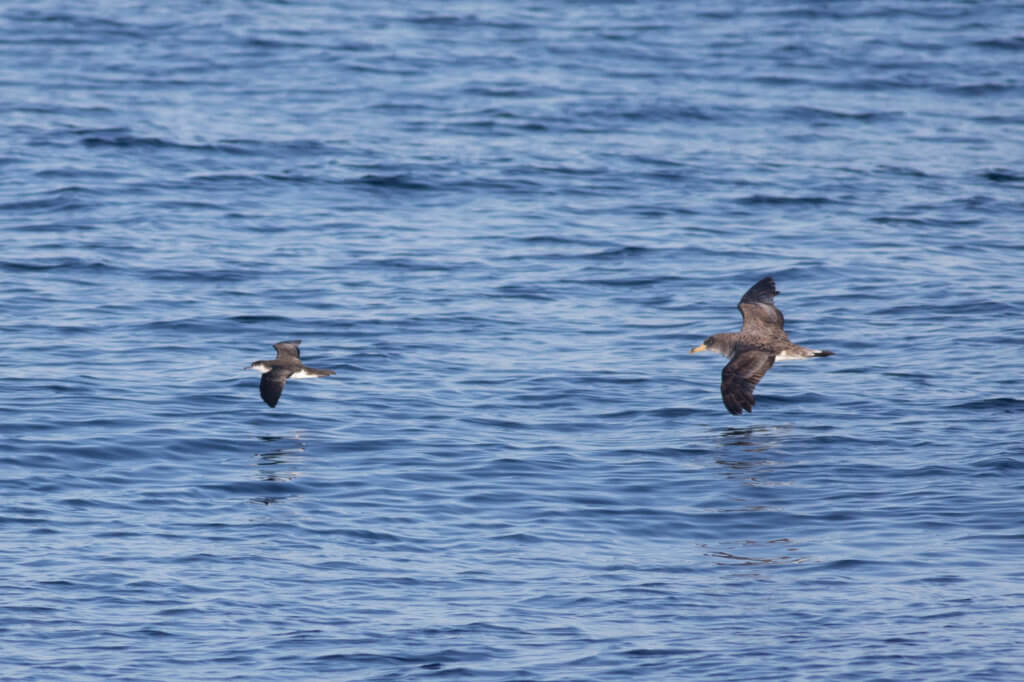
Audubon’s (left) and Cory’s Shearwaters. Photo credit Tom Johnson.
The shelf edge between Welker and Hydrographer Canyons was quiet, as was Hydrographer itself as we turned northward. A high-flying slim jaeger was spotted distantly in harsh light, which we left as Parasitic/Long-tailed in the field. Examination of photos revealed it to be a LONG-TAILED JAEGER, actually the more expected of the two smaller jaegers this far offshore. Ah, the wonders of technology.
Black-and-white and Cape May Warblers approached the boat, the Cape May particularly cooperative in that it made several passes and was quite vocal. An odd skeleton-like object was spotted floating on the water’s surface, and our curiosity demanded we check it out. We were a bit surprised to find an OCEAN SUNFISH (MOLA MOLA) very much alive but with one fin badly injured. Here’s hoping it is somehow able to survive that.
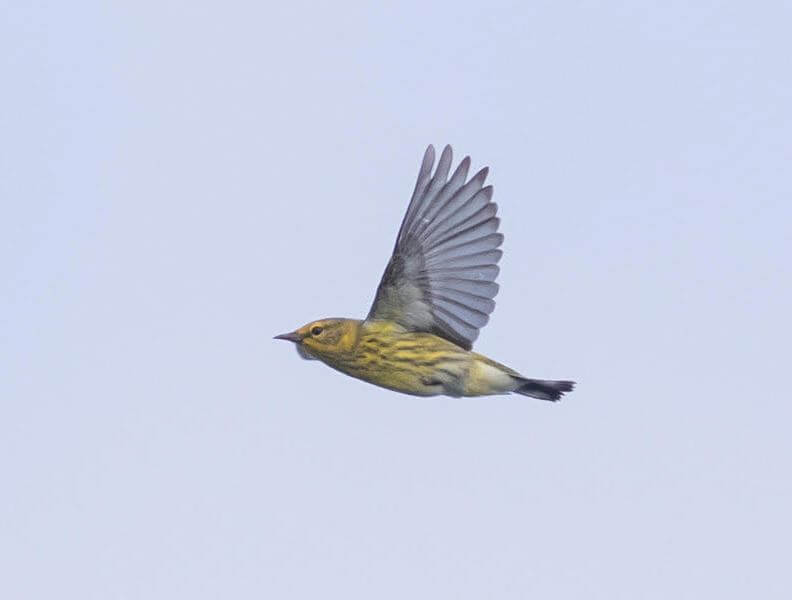
Cape May Warbler. Photo credit Tom Johnson.
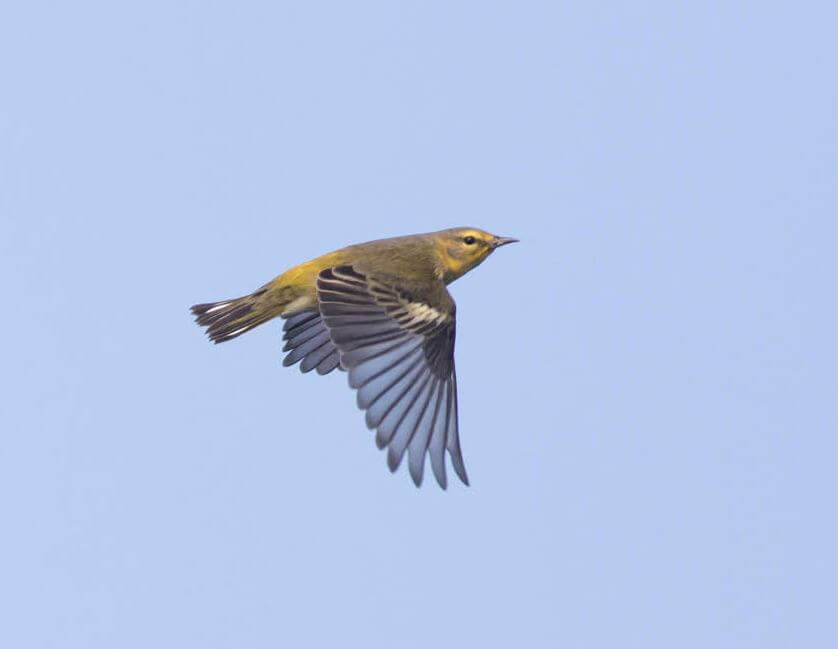
Cape May Warbler. Photo credit Tom Johnson.
We were about the leave our target waters at “the edge,” but we felt like we might still have a surprise or two left. As we retraced our steps towards home, away from the canyons and onto the continental shelf, we stumbled across a large concentration of birds only ½ mile from where we had seen those huge Fulmar numbers on Saturday. And just like the day before, the flock consisted of Wilson’s Storm-Petrels, Great Shearwaters, and Northern Fulmars. This time, several POMARINE JAEGERS were getting in on the action.
We were nearly ready to leave the scene when the call of “WHITE-FACED STORM PETREL!!” bellowed out. Everyone raced towards the front of the boat. There it was, kangaroo-hopping between the Wilson’s. Capt. Joe has mastered the art of following individuals of this species, so it was no surprise that he deftly put the bird off the port bow for all to see. This was our last reasonable chance at finding this sought-after specialty of these waters, which made the moment feel that much sweeter. Yet more yells and high fives and rounds of applause aboard the Helen H!
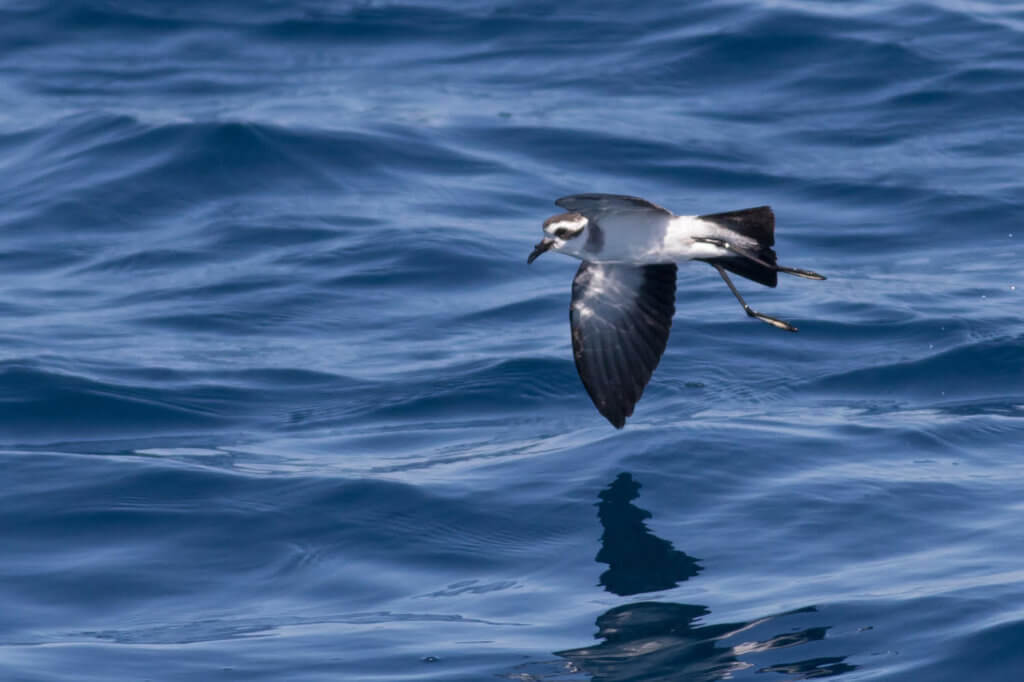
White-faced Storm-Petrel. Photo credit Tom Johnson.
Now truly headed for home, we still had to cross those productive waters of the Nantucket Shoals. Our first legit flock of phalaropes, a few dozen birds, contained a single RED among RED-NECKED, much to the delight of several on board who were able to tick yet another life bird! We followed this flock around for a few minutes and were able to study the differences between the two both on the water and in flight – the Red Phalarope being larger, paler, having a thicker bill and a broader white wing stripe.
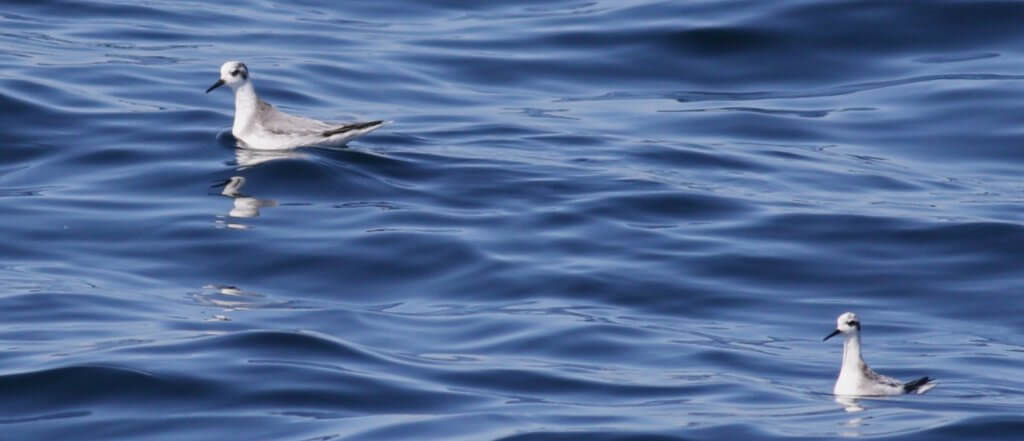
Red (left) and Red-necked Phalaropes. Photo credit Nick Bonomo.
The Shoals continued to produce with a few SOOTY SHEARWATERS, a new bird for the weekend. A pod of the always-playful SHORT-BEAKED COMMON DOLPHINS entertained us for a bit.
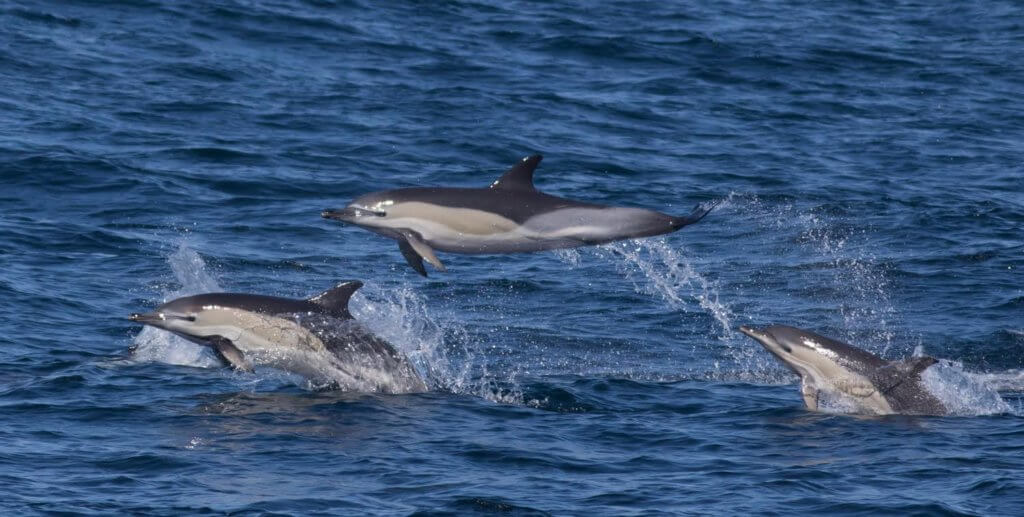
Short-beaked Common Dolphins. Photo credit Tom Johnson.
As we were trying to get better looks at the shearwaters, we noticed a hefty dark bird resting on the water…SKUA! Both North Atlantic skuas are possible in these waters at this time of year, so we would be taking an extra close and very open-minded look. This brute of a bird turned out to be a SOUTH POLAR SKUA, which allowed rather close approach as it sat calmly on the water. Eventually it tired of us and flew off, but not before everyone on board enjoyed awesome views. What a way to end the journey.
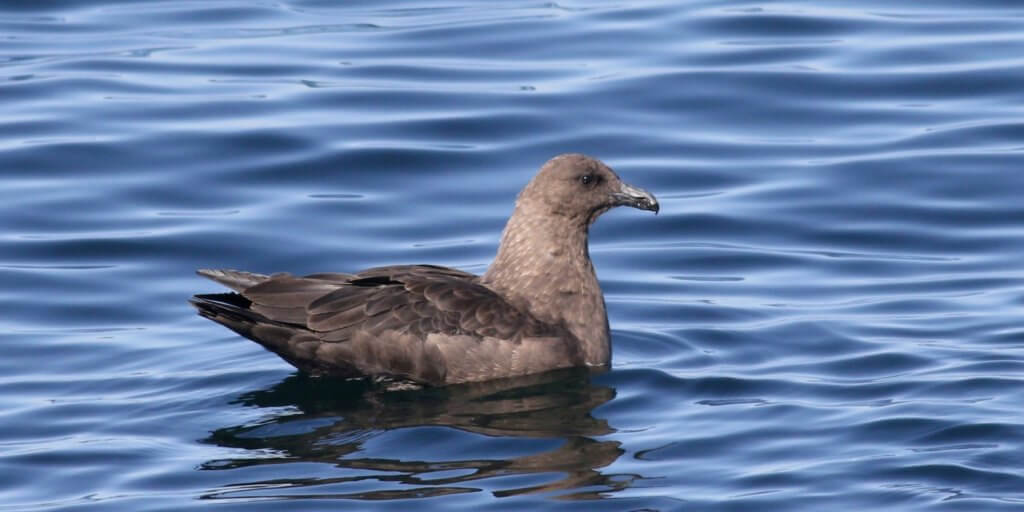
South Polar Skua. Photo credit Nick Bonomo.
We pulled into Hyannis that evening a rather elated group (understatement!!). Huge thanks are owed to Capt. Joe Huckemeyer and his crew led by Matt, to Naeem Yusuff and Bobbie Hodson for taking on the monumental task of organizing this event, and to every one of our participants for making this trip possible. Congrats to everyone on a BBC “Extreme” Pelagic that none of us will forget!
Cumulative Trip List
(Excluding Hyannis Harbor & environs. Hourly checklists submitted to eBird. Cumulative estimates below.):
|
|
Leaders: Luke Seitz (WINGS tour leader), Tom Johnson (FIELD GUIDES tour leader), Nick Bonomo (Connecticut Audubon Society EcoTravel tour leader), Naeem Yusuff, Bobbie Hodson
Below are two maps of our route as plotted by GPS: one full map and one zoomed to the shelf edge. Several highlights are marked by yellow pins. (Birds were marked where they were first sighted.)
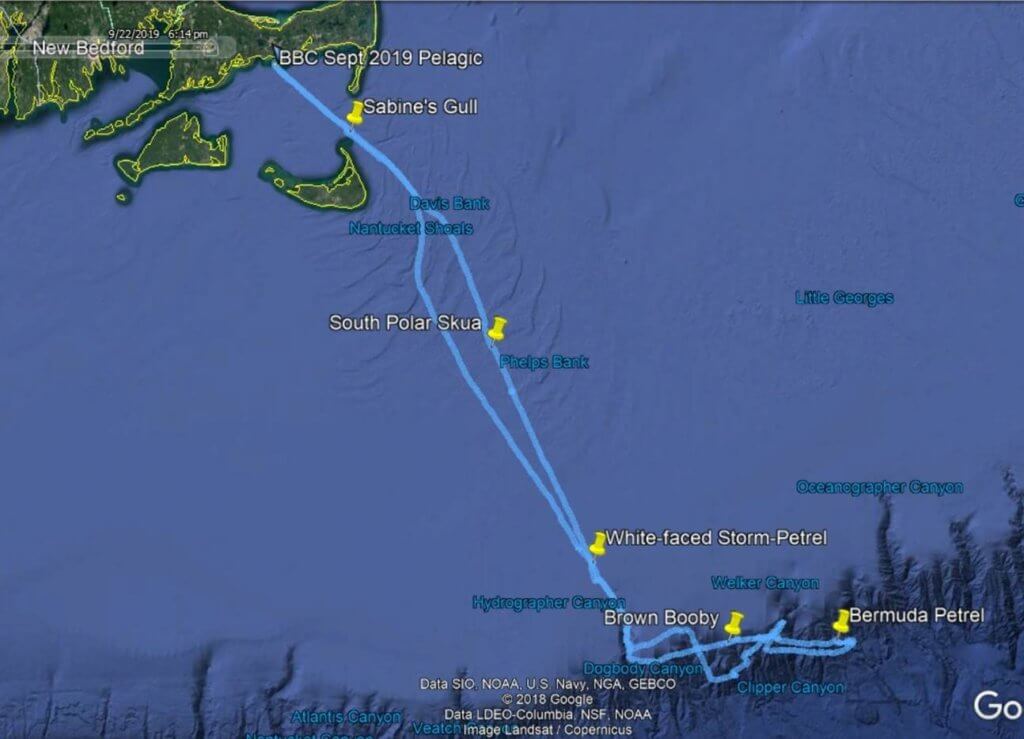
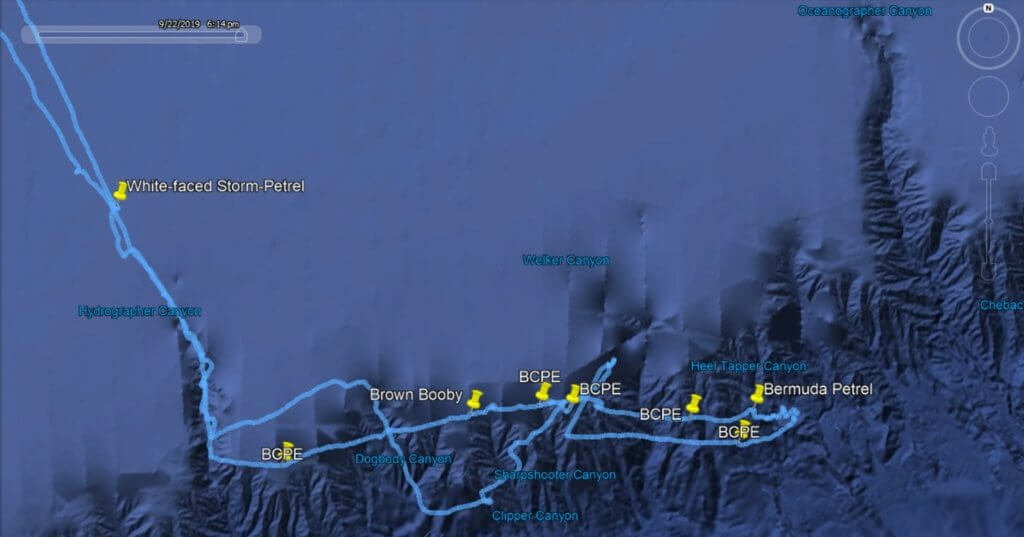
News Categories
Upcoming Field Trips
-
-
Winthrop Beach, Gull Focus
Let's explore Winthrop Beach for gulls and other birds. We'll focus on gull ID, including identification of subadult gulls and possible unusual winter visitors.
-
Belle Isle Marsh and Vicinity
Led by DCR staff. We will search on foot up to one mile, on flat, easy terrain for snowy owls and other raptors, native sparrows, finches, waterfowl, and other birds. This is a traveling program by car or bike. Prepare for ticks. Ages: Adults and kids 8 years+ with adult chaperone. Binoculars recommended. ADA/Reasonable Accommodations [...]
-
Dunback Meadow, Lexington
We will look for semi-hardy migrants and wintering birds including raptors. Fox Sparrow are often here at this time of year. Expect to walk about 3 miles on possibly muddy trails. Cosponsored with Menotomy Bird Club.
-
Neponset River Greenway, Mattapan to Milton (T accessible)
Enjoy an approximately 2-mile walk along the Neponset River Greenway on an accessible boardwalk and bike path. Let's see what we can find together! Beginners encouraged as well as more experienced birders. Limited mobility welcome but snow or ice may be present.
-
Belle Isle Marsh Reservation
Let's explore the East Boston side of Belle Isle Marsh in winter! We'll look for ducks, hawks, Bald Eagles, winter finches and many more birds! Belle Isle is a fantastic birding destination in any season. All of the trails are flat and easy, with a slight elevation on the small hill going through the meadow. [...]
